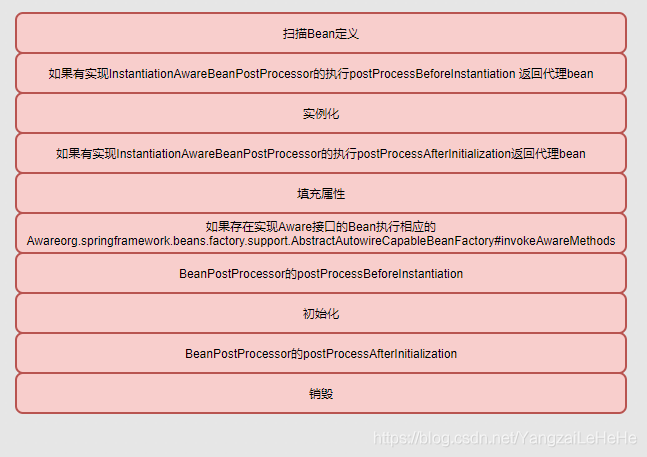Spring 中的bean 的生命周期有哪些步骤
文章目录
一、概述
简答来说分四步。实例化【Instantiation】?属性填充【populateBean】?初始化【initializeBean】?销毁【destroy】
详细如图:
二、细节:
1、实例化前的准备工作
首先这些所谓的Bean无论是通过XML配置亦或是注解形式都讲扫描后加载并赋值给BeanDefinition然后放入Map中进行存储,此时工厂中是没有Bean的。
2、关于InstantiationAwareBeanPostProcessor
实例化前会调用org.springframework.beans.factory.config.InstantiationAwareBeanPostProcessor#postProcessBeforeInstantiation方法。
try { // Give BeanPostProcessors a chance to return a proxy instead of the target bean instance. Object bean = resolveBeforeInstantiation(beanName, mbdToUse); if (bean != null) { return bean; } } catch (Throwable ex) { throw new BeanCreationException(mbdToUse.getResourceDescription(), beanName, "BeanPostProcessor before instantiation of bean failed", ex); }还有org.springframework.beans.factory.config.InstantiationAwareBeanPostProcessor#postProcessAfterInstantiation这个是在实例化之后执行的。
3、属性填充
属性填充前先会执行上面说到的org.springframework.beans.factory.config.InstantiationAwareBeanPostProcessor#postProcessAfterInstantiation
// Give any InstantiationAwareBeanPostProcessors the opportunity to modify the // state of the bean before properties are set. This can be used, for example, // to support styles of field injection. if (!mbd.isSynthetic() && hasInstantiationAwareBeanPostProcessors()) { for (BeanPostProcessor bp : getBeanPostProcessors()) { if (bp instanceof InstantiationAwareBeanPostProcessor) { InstantiationAwareBeanPostProcessor ibp = (InstantiationAwareBeanPostProcessor) bp; if (!ibp.postProcessAfterInstantiation(bw.getWrappedInstance(), beanName)) { return; } } } }然后填充BeanDefinition中的属性到实例Bean中
4、初始化
初始化的时候会先执行几个Aware方法如BeanNameAware、BeanClassLoaderAware、BeanFactoryAware,
执行Bean后置处理org.springframework.beans.factory.config.BeanPostProcessor#postProcessBeforeInitialization
然后进行初始化操作
执行Bean后置处理org.springframework.beans.factory.config.BeanPostProcessor#postProcessAfterInitialization
if (System.getSecurityManager() != null) { AccessController.doPrivileged((PrivilegedAction<Object>) () -> { invokeAwareMethods(beanName, bean); return null; }, getAccessControlContext()); } else { invokeAwareMethods(beanName, bean); } Object wrappedBean = bean; if (mbd == null || !mbd.isSynthetic()) { wrappedBean = applyBeanPostProcessorsBeforeInitialization(wrappedBean, beanName); } try { invokeInitMethods(beanName, wrappedBean, mbd); } catch (Throwable ex) { throw new BeanCreationException( (mbd != null ? mbd.getResourceDescription() : null), beanName, "Invocation of init method failed", ex); } if (mbd == null || !mbd.isSynthetic()) { wrappedBean = applyBeanPostProcessorsAfterInitialization(wrappedBean, beanName); }
5、销毁
当Bean不再需要时,会经过清理阶段,如果Bean实现了DisposableBean这个接口,会调用其实现的destroy()方法;如果这个Bean的Spring配置中配置了destroy-method属性,会自动调用其配置的销毁方法。
单例Bean会放在单例池中。
